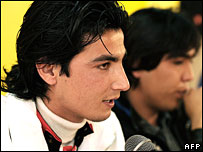Leadership and skill. An
In the dust, heat and danger of Afghanistan's Zhari District, Maj. David Quick of the Royal Canadian Regiment earned the medal for bravery [Star of Military Valour--only the VC is higher] he will receive from the Governor General in a ceremony today at Rideau Hall.
Maj. Quick, 34, was cited for courage under fire as he led his men in India Company against Taliban insurgents this past summer in battles in which the enemy was so close "you could hear them changing magazines," Maj. Quick said. "The ground didn't allow us to get any further back."
After being ambushed by insurgents one day last June, one of his soldiers turned around the corner of a building and stumbled on an enemy fighter just metres away and shot him dead. "You don't get any closer than that without fixing your bayonet."
Maj. Quick then instructed his artillery officer to call in airstrikes while his soldiers returned fire to hold the enemy in place.
The fight was over after F-15 fighter jets fired about 20 rockets just 20 metres from where the Canadian troops were holed up.
In situations like that, rank makes little difference, Maj. Quick said. "You're just a weapon like everybody else. You have to fight your way out."
He did plenty of that on his six-month tour in Afghanistan, preferring to lead by example rather than give orders from the rear.
That approach demonstrated to his troops that he would only lead them into situations he felt comfortable with, he said.
And it worked. Through 24 combat operations, including 16 with fighting at close quarters, with anywhere from 80 to almost 200 soldiers under his command, Maj. Quick did not lose a single Canadian soldier.
"That in itself is my greatest personal success. I'll never be able to duplicate that in my life."
Maj. Quick, based in Gagetown, N.B., will be the sole recipient of the Star of Military Valour when Gov. Gen. Michaëlle Jean presents 36 decorations today.
His responsibility in Afghanistan was to ensure the dangerous Zhari district west of Kandahar City was stable and secure, said his boss, Lieut.-Col. Robert Walker.
"That was his main task. Pretty daunting because, by the time summer came, the foliage was up and we were restricted in moving down a lot of those roads. There were (improvised explosive devices) in a lot of those roads," he said.
Maj. Quick learned that the hard way when his light armoured vehicle ran over a landmine in April. Though his head was exposed, he escaped with only a concussion and some inner-ear damage. The explosion blasted two wheels off the vehicle, but there were no casualties.
Over the next few months he went on to spearhead several intense combat missions -- as many as two a week -- against a Taliban threat no longer preoccupied with the poppy harvest or hampered by winter.
"Throughout, he showed exceptional courage, leading from the front. And it was because of his strength of character, his willpower, his physical fitness and his tactical acumen," Lieut.-Col. Walker said.
Maj. Quick's military life began somewhat by fluke. While in high school, he applied for pilot training at the Royal Military College, like every other kid in Trenton, he said.
His colour-blindness, however, got him rejected. While in his first year at the University of Guelph, he was approached by recruiters offering him a spot in an intensive military training program.
Having spent most of his money at a campus pub, he accepted.
Tours in Bosnia, Kosovo and Haiti then helped accustom him to the constant threat of violence he would face in Afghanistan.
"But up to that point, I wasn't killing anybody," Maj. Quick said.
And there is no substitute for the intense experience of combat in close quarters, he added.
For all of NATO's military technology, fighting in Afghanistan is not much different from the wars of previous generations.
Light-armoured vehicles are of little use in the more rugged terrain and are too dangerous on roads spiked with improvised explosive devices.
In regions teeming with Taliban fighters under the cover of dirt buildings and summer foliage, Canadian battalions travel by foot and face insurgents within a stone's throw, much like the Vietnam War, said Maj. Quick.
That shrunken battlefield also meant he would have to call in air strikes targeting his own position, he said.
"You'd mark yourself off, à la Vietnam, with red smoke, and the A-10 would kill everything around you."
The Air Force lost a good one.














